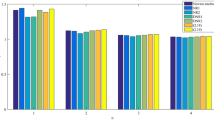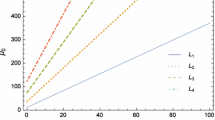Abstract
In this work, we briefly talk about the incorrect convergence order presented in the paper Khan et al. (Appl. Math. Lett. 25:2262–2266, 2012). Accordingly, we first show that their convergence theorem includes major errors, and it is attempted to provide the correct error equation of their method having fifth-order not eighth-order convergence. Finally, to support our assertion, some numerical examples are tested.
Similar content being viewed by others
Avoid common mistakes on your manuscript.
Convergence analysis
Khan et al. [1], proposed the following three-step iterative method
where
and and represent a real-value function.
Khan et al. assert that if the conditions of the following theorem hold, then the iterative method (1.1) has convergence order eight (see Theorem in Section 4 in [1]). However, we prove that this is not true and prove that its convergence order is five.
Theorem 1.0.1
Let have a single root , for an open interval . If the initial point is sufficiently close to , then the sequence generated by any method of the family (1.1) converges to . If is any function with , , and , then the methods defined by (1.1) have convergence order of at least 5.
Proof
For the sake of simplicity, we drop the iterative index . Let , and . Since , we can write
Let . Then,
Set,
Now, define the weight function by
Then,
If and , then
Now, assume that , and are given by (1.2). Also, let and . Consequently, the final error equation, i.e., , for the method (1.1) is obtained as follows
which completes the proof. □
Numerical performances
This section concerns with numerical results of the proposed methods (1.1). We take the derived method from it by considering and , where . This is the Method 1 in [1] (see Equations 21 and 22 in Section 5 there.)
where
Numerical results have been carried out using Mathematica 9 with 200 digits of precision. means . In each table, COC stands for computational order of convergence (see [1]) which is given by
Among many test problems, the following four examples are considered
To sum up, it can be concluded the that the method (1.1) has fifth-order convergence. Therefore, authors’ claim is not true that they have presented a family of iterative methods for solving nonlinear equations with eighth-order convergence.
Reference
Khan, Y., Fardi, M., Sayevand, K.: A new general eighth-order family of iterative methods for solving nonlinear equations. Appl. Math. Lett. 25, 2262–2266 (2012)
Acknowledgments
The author thank to the anonymous referees for their valuable comments and for the suggestions to improve the readability of the paper.
Author information
Authors and Affiliations
Corresponding author
Additional information
This research was supported by Islamic Azad University, Takestan Branch.
Rights and permissions
This article is published under license to BioMed Central Ltd.Open Access This article is distributed under the terms of the Creative Commons Attribution License which permits any use, distribution, and reproduction in any medium, provided the original author(s) and the source are credited.
About this article
Cite this article
Taher-Khani, S. A note on the paper “A new general eighth-order family of iterative methods for solving nonlinear equations”. Math Sci 8, 123 (2014). https://doi.org/10.1007/s40096-014-0123-8
Received:
Accepted:
Published:
DOI: https://doi.org/10.1007/s40096-014-0123-8




